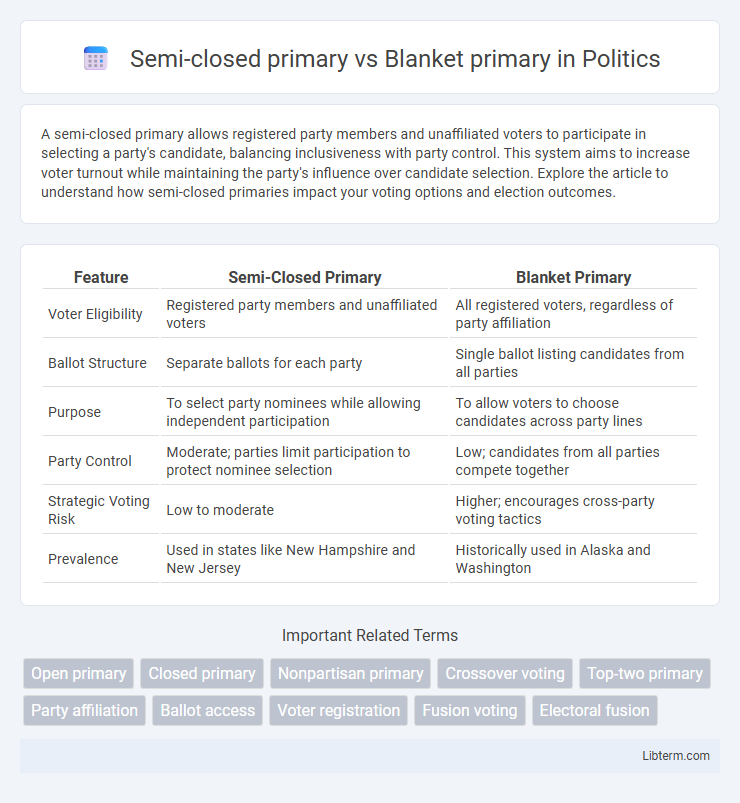A semi-closed primary allows registered party members and unaffiliated voters to participate in selecting a party's candidate, balancing inclusiveness with party control. This system aims to increase voter turnout while maintaining the party's influence over candidate selection. Explore the article to understand how semi-closed primaries impact your voting options and election outcomes.
Table of Comparison
| Feature | Semi-Closed Primary | Blanket Primary |
|---|---|---|
| Voter Eligibility | Registered party members and unaffiliated voters | All registered voters, regardless of party affiliation |
| Ballot Structure | Separate ballots for each party | Single ballot listing candidates from all parties |
| Purpose | To select party nominees while allowing independent participation | To allow voters to choose candidates across party lines |
| Party Control | Moderate; parties limit participation to protect nominee selection | Low; candidates from all parties compete together |
| Strategic Voting Risk | Low to moderate | Higher; encourages cross-party voting tactics |
| Prevalence | Used in states like New Hampshire and New Jersey | Historically used in Alaska and Washington |
Understanding Primary Election Systems
Semi-closed primary systems allow registered party members and unaffiliated voters to participate in a party's primary, enhancing voter inclusivity while limiting crossover influence. Blanket primaries permit all voters to choose candidates from any party for each office, maximizing voter freedom but potentially diluting party control over candidate selection. Understanding these primary election systems is crucial for analyzing their effects on party dynamics, voter engagement, and electoral outcomes.
What is a Semi-Closed Primary?
A semi-closed primary restricts voting to registered party members and unaffiliated voters, allowing independents to participate while excluding members of other parties. This system aims to balance party control over candidate selection with increased voter inclusivity. Unlike blanket primaries, where all candidates appear on a single ballot regardless of party, semi-closed primaries maintain clearer party boundaries to preserve partisan integrity.
What is a Blanket Primary?
A Blanket Primary allows all registered voters to select candidates from any party for each office on the ballot, providing maximum voter flexibility. Unlike a Semi-closed Primary, where unaffiliated voters can participate but registered party members can only vote within their own party, Blanket Primaries do not restrict choices based on party affiliation. This system can lead to a more diverse candidate selection and potentially influence cross-party appeal during elections.
Key Differences Between Semi-Closed and Blanket Primaries
Semi-closed primaries restrict voting to registered party members and independents, allowing independents to choose which primary to participate in, while registered party members vote only in their own party's primary. Blanket primaries enable all registered voters to select candidates across party lines for each office, offering maximum flexibility but potentially diluting party influence. Semi-closed systems maintain stronger party control over candidate selection, whereas blanket primaries emphasize voter choice and cross-party competition.
Voter Participation and Inclusion
Semi-closed primaries limit participation to registered party members and unaffiliated voters, increasing party control but potentially reducing overall voter inclusivity. Blanket primaries allow all registered voters to choose candidates across party lines, boosting broad participation and voter engagement. While blanket primaries promote inclusivity and diverse voter input, semi-closed primaries maintain clearer party alignment and candidate selection integrity.
Impact on Political Parties
Semi-closed primaries limit participation to registered party members and unaffiliated voters, thereby strengthening party control over candidate selection and preserving party cohesion. Blanket primaries allow all voters, regardless of party affiliation, to choose candidates from any party, often diluting party influence and leading to more moderate nominees. The semi-closed system supports party identity and loyalty, while blanket primaries encourage cross-party voting but may weaken party unity and candidate accountability.
Advantages of Semi-Closed Primaries
Semi-closed primaries enhance party control by allowing registered party members and unaffiliated voters to participate, increasing voter turnout while maintaining party influence in candidate selection. This system reduces the risk of crossover voting compared to blanket primaries, where all voters can select candidates from any party, potentially diluting party objectives. States like New Hampshire benefit from semi-closed primaries by balancing inclusivity with party cohesion, fostering stronger party loyalty and more representative candidate choices.
Advantages of Blanket Primaries
Blanket primaries allow voters to select candidates from all parties on a single ballot, maximizing voter choice and encouraging broader voter participation. This system can lead to the nomination of more moderate candidates by exposing voters to a wider range of options beyond party lines. The increased electoral competition in blanket primaries often results in candidates who appeal to a diverse electorate, enhancing overall democratic representation.
Criticisms and Controversies
Semi-closed primaries face criticism for potentially limiting voter participation by restricting unaffiliated voters from participating in party-specific contests, raising concerns about inclusivity and fairness. Blanket primaries attract controversy for allowing voters to select candidates from multiple parties on the same ballot, which opponents argue can dilute party loyalty and enable strategic voting that distorts primary outcomes. Legal challenges have also targeted blanket primaries, with courts questioning their impact on political party rights and the integrity of the nominating process.
Which Primary System is Most Effective?
The semi-closed primary system allows registered party members and independents to participate, balancing party control with broader voter inclusion, which often leads to more moderate candidate selections. Blanket primaries open voting to all registered voters regardless of party affiliation, fostering greater voter participation but sometimes weakening party cohesion and candidate loyalty. Empirical studies suggest semi-closed primaries tend to produce candidates with stronger party support while maintaining voter engagement, making them more effective in promoting both party interests and electoral competitiveness.
Semi-closed primary Infographic

 libterm.com
libterm.com